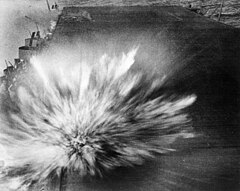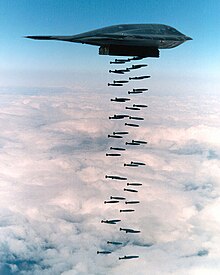Bomba

Bomba – broń w postaci ładunku materiału wybuchowego, zazwyczaj w specjalnej obudowie, wyposażonego w mechanizm detonujący (zapalnik). Służy przede wszystkim do niszczenia obiektów siłą energii wybuchu, rażąc odłamkami lub wywołując pożar. Bomby zaliczane do broni masowego rażenia zamiast materiału wybuchowego posiadają atomowy, biologiczny lub chemiczny ładunek bojowy.
Określenie „bomba” w ujęciu wojskowym odnosi się przeważnie do amunicji zrzucanej ze statków powietrznych (bomby lotnicze) albo zrzucanej z samolotów lub okrętów i służącej do zwalczania okrętów podwodnych (bomby głębinowe). Dawniej była to także amunicja artyleryjska w kształcie kuli wypełnionej prochem zapalanym za pomocą lontu. Z drugiej strony bombami nazywa się też naziemne urządzenia wybuchowe, stacjonarne lub przenośne, używane najczęściej w celach kryminalnych lub terrorystycznych (porównaj wojskowe: mina i fugas).

Rodzaje bomb
- bomba atomowa
- bomba elektromagnetyczna
- bomba głębinowa
- bomba kasetowa
- bomba lotnicza
- bomba paliwowo-powietrzna
Inne podziały bomb
Główne:
- burzące
- odłamkowe
- burząco-odłamkowe
- kulkowe
Specjalne:
- oświetlające
- błyskowe
- sygnalizacyjne
- propagandowe
Bomby będące bronią masowego rażenia:
- bomba atomowa (jądrowa)
- bomba biologiczna
- bomba chemiczna
- bomba termojądrowa (bomba wodorowa)
- brudna bomba
- bomba próżniowa
Zobacz też
Bibliografia
- PWN Leksykon: Wojsko, wojna, broń, Wydawnictwo Naukowe PWN, Warszawa 2001, ISBN 83-01-13506-9
Media użyte na tej stronie
A Massive Ordnance Air Blast- or more commonly known as the Mother of All Bombs -(MOAB) weapon is prepared for testing at the Eglin Air Force Armament Center on March 11, 2003. The MOAB is a precision-guided munition weighing 21,500 pounds and will be dropped from a C-130 Hercules aircraft for the test. It will be the largest non-nuclear conventional weapon in existence. The MOAB is an Air Force Research Laboratory technology project that began in fiscal year 2002 and was scheduled to be completed in 2003. DoD photo. (Released) 030311-D-9085M-007
A B-2 Spirit dropping Mk.82 bombs into the Pacific Ocean in a 1994 training exercise off Point Mugu, California, near Point Mugu State Park.
A Japanese bomb explodes on the flight deck of USS Enterprise, 24 August 1942 during the Battle of the Eastern Solomons, causing minor damage. This was the third and last bomb to hit Enterprise during the battle. The bomb was dropped by a Japanese Aichi D3A1 "Val" dive bomber piloted by Kazumi Horie who died in the attack.
Amerykańska bomba burząca AN-M56 wagomiaru 4000 funtów





